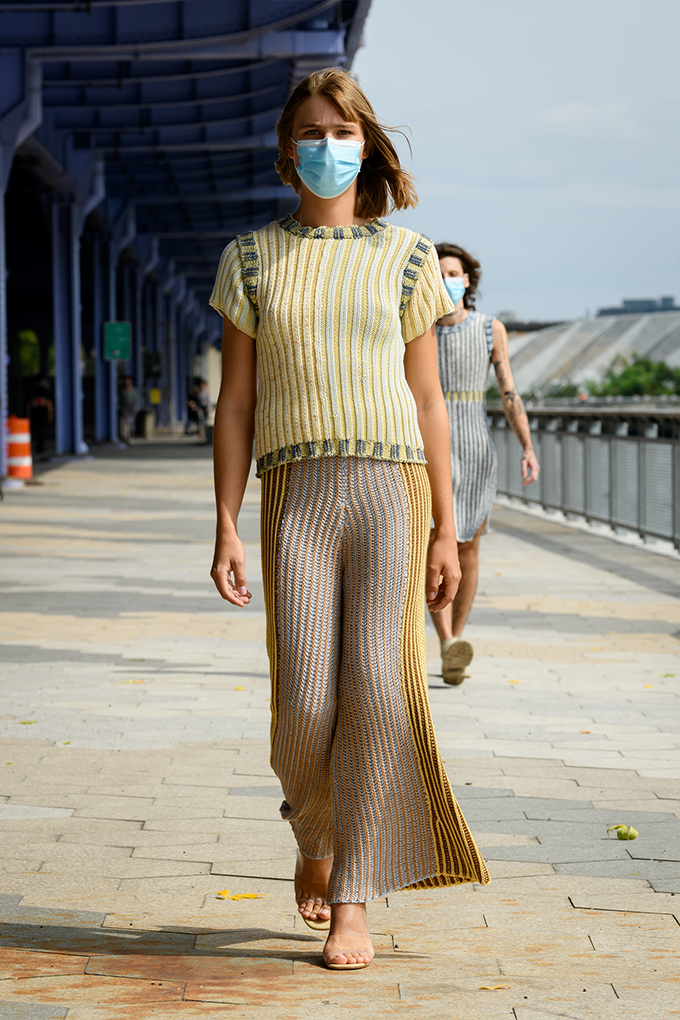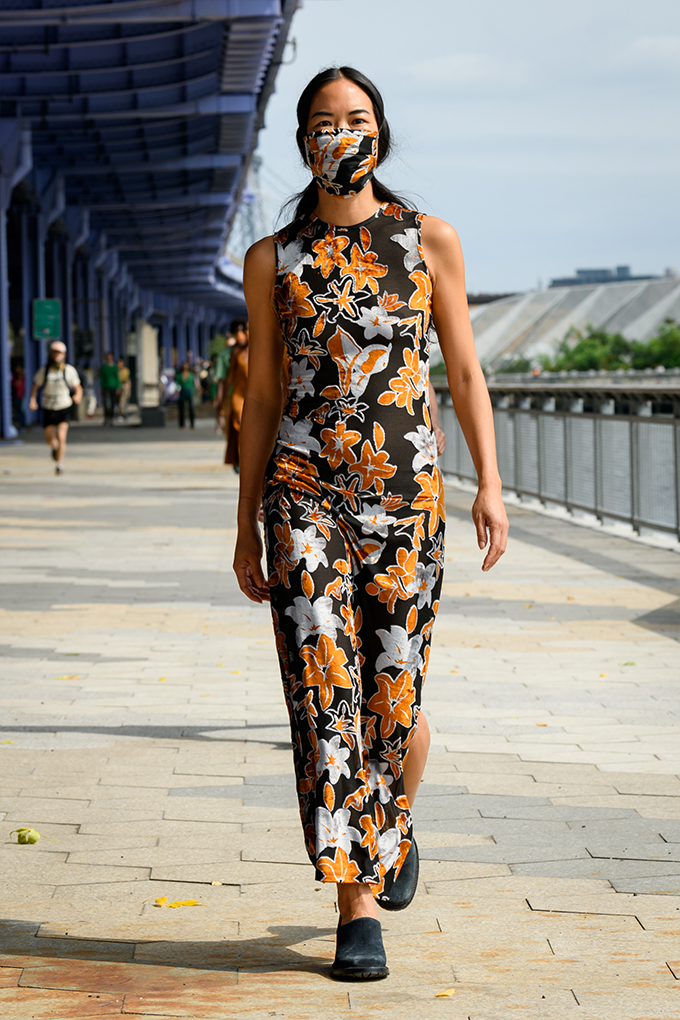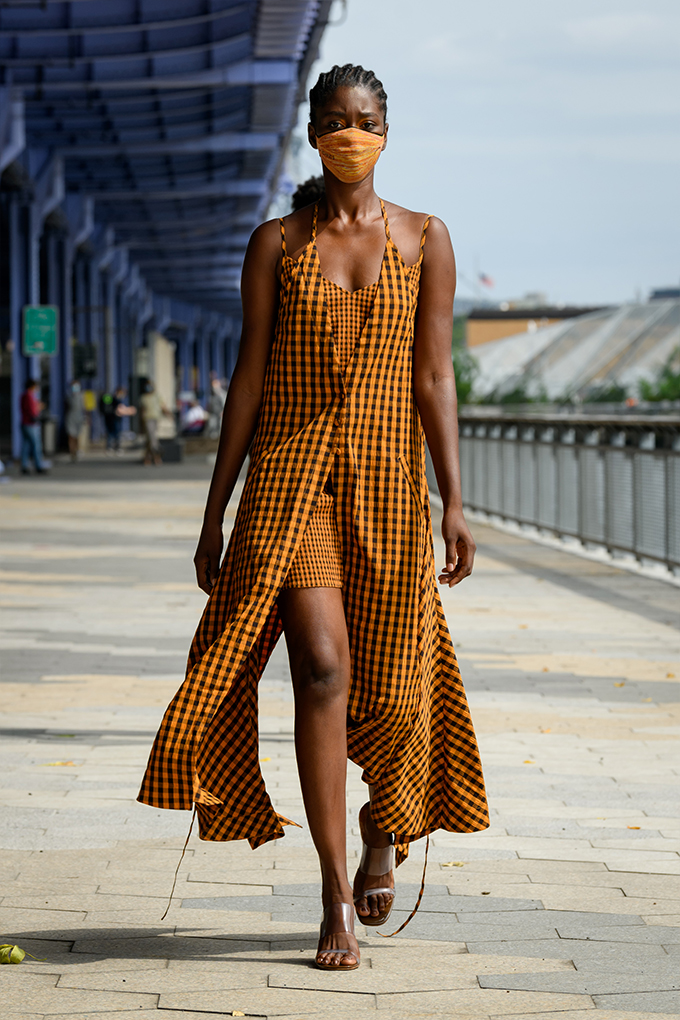When I connect with Mike Eckhaus and Zoe Latta ahead of their show on 18 September, the former appears on Zoom wearing an Eckhaus Latta face mask pulled from the duo’s new collection. Behind Eckhaus, there is a flurry of activity, as clothes are pulled off rails and fitted on models, while he holds up some of the meticulously crafted crocheted pieces and printed knits they’ve been working over the past six months during lockdown. “Sorry,” Eckhaus says. “It’s a little chaotic right now.”
A chaotic showroom is nothing out of the ordinary for a brand one day away from showing its SS21 collection for New York Fashion Week. What makes it particularly unusual, however, is the fact Latta is dialling in from Santa Cruz, California, where she has spent the day helping guide the styling and making executive decisions on the collection remotely. The pair may be used to designing their collections bicoastally, but it’s the first time they’ve had to put a show together separately. “It’s devastating of course, but it wouldn’t have been responsible for me to be there right now,” says Latta.
If there’s one thing that has come to define Eckhaus Latta since the brand first launched back in 2011, though, it’s a spirit of resourcefulness. Whether through upcycling unlikely fabrics into garments as offbeat as they are desirable, or the DIY feel of the shows that regularly feature the pair’s close-knit circle of friends and collaborators, the brand’s unique ability to reflect the duo’s surroundings with piercing clarity is present once again in their latest collection. Staged under the shadow of the Manhattan Bridge to a handful of New York-based fashion editors and buyers, and streamed live on the Eckhaus Latta website, the show format is intended as a timely ode to the walks that have punctuated our days during lockdown.
Read more: Vogue Viewpoint: Debra Langley on the future of fashion retail, technology and sustainability

Here, Eckhaus and Latta tell Vogue about the unlikely efficiency of working across states and time zones, the genesis of the idea for their latest show, and how a sense of community was fundamental to helping them through the past six months.
How have you navigated lockdown as a brand and a business?
Eckhaus: At the beginning of lockdown, we were coming off our biggest collection yet, so there was a lot of momentum and we were running off that adrenaline. When [lockdown] first hit, it felt like running into a brick wall. But it gave us the opportunity to rethink how much clothing we were making, and who we were making it for. It allowed us to slow down and work in a different, smarter way. The fact the collection is significantly smaller is basically our reflection on that.
Latta: Adapting to this new landscape has meant reassessing the core values of Eckhaus Latta, and what we’re showing today is a distillation of that. It’s been nice to take a step back, so we can be more intentional in what we’re doing moving forward.
Did your history of working bicoastally help you navigate the challenges of the pandemic?
Eckhaus: I’ve actually never thought about that, but it’s very true. We’ve been lucky in the sense that we’ve worked this way for so long. We have teams on both coasts, so it wasn’t too much of a rude awakening [to work this way].
Latta: We’re used to it, but I think Mike and I, and our respective teams, really miss each other. We’re suited for this in some way for sure, but it’s always better to be in a room making things with other people.
Are there any less obvious ways in which the clothes reflect the present moment?
Eckhaus: I feel like a lot of this collection is about trying to find a sense of ease that feels right for now, but also knowing that life isn’t going to be just working from home in sweatpants all the time, even if you do need to speak to that in some way.
Latta: This is the first time we’ll be showing sweatpants, but it’s not about athleisure. We can also safely say this is the most unisex collection we’ve ever made, but in a neutral way. It’s been interesting for us, because we’re not proposing that sweats are the future, but you can still find a way to be a little flashy in sweats that doesn’t have to be a straight-up tracksuit.










Was the close-knit community of fans and collaborators you’ve cultivated around the brand useful during lockdown?
Latta: Part of the reason why we’re so lucky to still be existing now, as Eckhaus Latta, is because our customer has remained so loyal throughout all of this. We’re really thankful for that. And also within that, we’ve still been closely in touch with our friends, our community, our collaborators, whether it’s over Zoom or going on socially distanced walks together.
And just hearing from them and observing the shifts in what they want has helped inform what we’re doing. It was also seeing what sold from our spring/summer 2020 collection, which was our biggest ever. It was great—for lack of a better word—market research for us.
Tell me more about your decision to stage the show in this semi-digital, semi-physical format?
Eckhaus: I feel like for us, over the past few months the reality is that we still go outside and walk on the street, and still interact with our communities when we can. We’ve all been trying to avoid leading a life that exists purely in the digital realm. Over the past few years, our show production has become much larger—at least for us, in our world. Obviously, in the grand scheme of fashion, it’s nowhere near what some of the bigger brands do. But the question was really, how do we adapt? How do we make sure we don’t lose that feeling we’ve built up?
Latta: Our biggest fear was to have a show that felt tone deaf to change, or that we were trying to continue doing a fashion show just for the sake of it, in a stubborn way. I hope it doesn’t come across like that. But as Mike says, it doesn’t mean it has to be purely digital. This format is great because it can still be experienced digitally, but our biggest intention was to present the collection in a way that felt relevant to how we’re living our lives right now. We’ve changed locations a number of times for safety or for the context, but we just wanted to recreate that feeling of going on a walk, which is something we’re all still doing right now. We didn’t want to create a lookbook that was just a digital fantasy, because honestly, we’re not living that.





